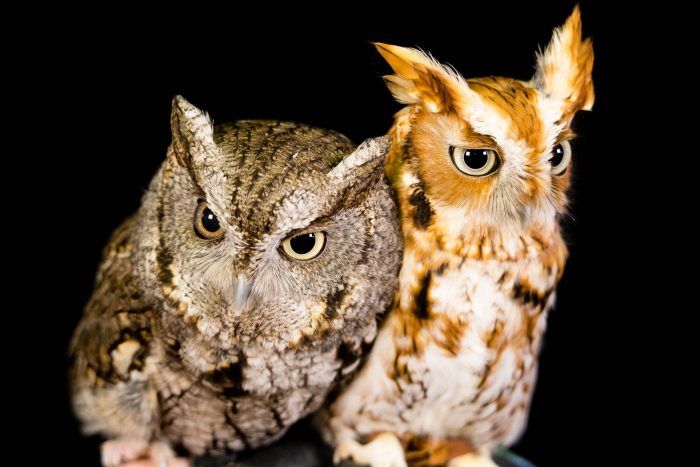Eastern screech-owl
Megascops asio
This small, well-camouflaged owl can be found year-round throughout forested areas of the Bay watershed.
This section shows one large critter image at a time. Use the thumbnails that follow to select a specific image to display here.

This gallery contains a grid of small thumbnails. Selecting a thumbnail will change the main image in the preceding section.
Appearance
Eastern screech-owls are small, from 6 to 10 inches in length with a wingspan of 19 to 24 inches. As with many owls, females are generally larger than males. They come in two distinct color morphs: gray and rufous (reddish-brown). Whatever color they are, they are patterned with bands and spots that act to camouflage them with tree bark. They have bold streaking on their breasts and "ear" tufts on either side of their head.
Feeding
The Eastern screech-owl’s diet includes insects, invertebrates, amphibians and reptiles such as moths, katydids, crayfish, earthworms, tadpoles, frogs and lizards. They eat many kinds of mammals, including rats, mice, squirrels, moles and rabbits. Small birds taken as prey include flycatchers, swallows, thrushes, waxwings and finches, as well as larger species such as jays, grouse, doves, shorebirds and woodpeckers.
These owls have excellent hearing and can often capture prey hidden under leaves.
Predators
Eastern screech-owls are preyed on as adults and fledglings by larger owls, hawks and other eastern screech-owls. Eggs and nestlings may be taken by black rat snakes, Virginia opossums, raccoons and ringtails.
Flight
Most flights are short (less than 75 feet). When traveling between perches, eastern screech-owls often drop, fly straight, and then rise again in a U-shaped pattern.
Voice
The owl’s call is a mournful whinny or wail; tremulous, descending in pitch. Sometimes it is a series on a single pitch.
Reproduction and life cycle
Eastern screech-owls form stable pairs—usually one male with one female, but occasionally one male with two females. Eastern screech-owl pairs usually are monogamous and remain together for life, but some makes might mate with two different females. The second female may evict the first female, lay her own eggs in the nest and incubate both clutches.
Breeding occurs once a year from February through March. The female lays her eggs on whatever debris is at the bottom of her nesting cavity, such as wood-chips, twigs or the feathers and droppings from a previous year’s nest (females re-use successful nesting sites).
Eastern screech-owl females incubate the eggs and brood the young (sit on the eggs for warmth and safety). Males feed females and guard nest cavities during incubation and brooding. Clutches usually contain 2 to 6 eggs with 27 to 34 days of incubation. The young leave the nest at about 28 days old and remain with the parents until they are 8 to 10 weeks old. Both parents feed the young during this period. It is estimated that only 30 to 50 percent of young from one year survive into the next year.
Did you know?
- Although the eastern screech-owl looks similar to its cousin, the western screech-owl, they are easy to distinguish as their territories don’t overlap and they have different calls.
- Eastern screech-owls are sometimes the most abundant and important small predator in urban and suburban forested areas.
- These owls have been known to deliberately bring live animals, such as blind snakes, into their nests. These animals feed on ants, flies and other insects that infest the nest cavity.
- Looking for eastern screech-owls during the day? Listen for a commotion of small birds such as blue jays, chickadees and titmice. They may be mobbing a screech-owl, swooping around it with loud calls. They do this in order to make the owl move, thus alerting other birds to the predator’s presence and teaching younger birds about the danger.
- The oldest known wild eastern screech-owl was at least 14 years, 6 months old.
Sources and additional information
- All About Birds: Eastern Screech-Owl – The Cornell Lab of Ornithology
- Animal Diversity Web: Otus asio – University of Michigan Museum of Zoology
- Birds of Eastern and Central North America by Roger Tory Peterson
- Eastern Screech-Owl – Audubon Field Guide to North American Birds
